Are you ready to face your arachnophobia? Even the bravest of us can usually be found cowering at the sight of a spider scurrying across the floor. But, did you know there are various types of spiders, that can jump?
There are approximately 5,000 spider species that have the ability to jump. But, only a small fraction of these jumping spiders display a predominantly black coloration.
If you still want to know exactly what species of black spiders can jump, or you just want to revel in fear! Then stick around until the end for an incredible in-depth look at these black spiders.
5 Black Spiders That Can Jump
Black spiders that can jump are typically found in different regions across the world. They also have different characteristics, and sizes, with some being more noticeable than others. However, with so many black spiders out there, it can be hard to identify the ones that can jump.
So to help you identify these spiders, below you will find the types of black spiders that can jump but also where they can be found as well as offer advice on how best to handle them if encountered.
1. Bold Jumping Spider
The Bold Jumping Spider (Phidippus audax) is a fascinating species known for its remarkable jumping abilities. These agile spiders can leap several times their body length in a single bound, which not only allows them to navigate their environment efficiently but also enables them to capture prey with precision.
This Bold Jumping Spider possesses a highly developed muscular and hydraulic system that facilitates their extraordinary jumping skills.
They have strong legs, particularly their front legs, which provide the necessary force to propel them into the air.
Additionally, they use their internal hydraulic pressure system to extend their legs quickly, further enhancing their ability to make impressive leaps.
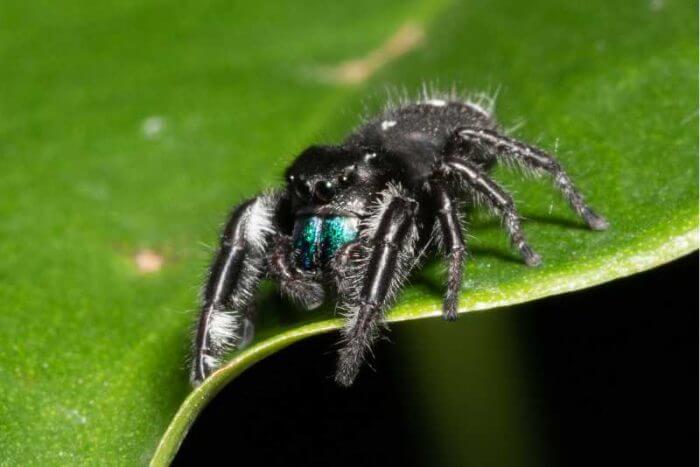
Aside from their jumping prowess, Bold Jumping Spiders are known for their exceptional vision. They have four pairs of eyes, with two large, forward-facing eyes providing them with excellent depth perception and the ability to see in color.
This keen eyesight plays a crucial role in their hunting strategy, allowing them to spot and track their prey effectively before making their decisive jump.
They can typically be found around Canada and the Coastal states of west California and will nest in open woodlands, grasslands, and agricultural fields.
Characteristics
- Black body with white, silvery stripes
- Four pairs of eyes, with two large eyes
- Ovoid abdomen and round cephalothorax
- Iridescent green chelicerae
Size
- Adult female size ranges from 8-15 mm in body length
- Adult males are slightly smaller, 6-13 mm in body length
2. Zebra Spider
Zebra Spiders (Salticus scenicus) are well-known for their exceptional jumping abilities, which sets them apart from many other spider species. These jumping skills play a crucial role in their hunting strategy and help them navigate their environment efficiently.
Zebra Spiders can jump up to 100mm which is very impressive considering they are only a few millimetres in size.
This allows them to swiftly close the gap between themselves and their prey or escape potential threats.
The zebra spider also possesses exceptional vision, of 360° this is called “integral binocular vision”) which plays a vital role in coordinating their jumps.
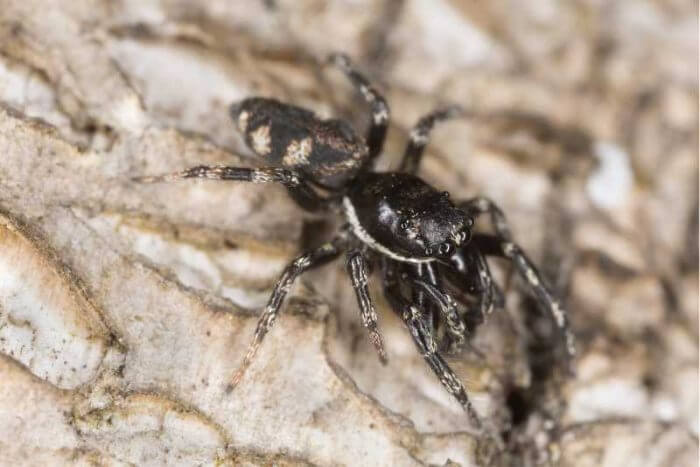
They have a total of eight eyes, with four forward-facing eyes and two on either side at the top of their head. This helps them accurately judge the distances and track moving targets before the spider makes it move.
They rely on their vision and agility to stalk and ambush insects, such as flies and ants. Once they have identified a target, they carefully position themselves, ready to jump to seize their prey.
Zebra spiders can be found across Europe, North America, and Asia, and typically love nesting in tiny crevices, such as rock faces, tree trunks, and garden fences.
Characteristics
- Black body with white coloration
- 3 to 4 white stripes located on its abdomen
- Female legs tend to be lighter in color compared to the male
Size
- Female zebra spiders are 5–9 mm long, while males are 5–6 mm
- Male zebra spiders have a larger chelicerae than females
3. Brown Recluse
The Brown Recluse (Loxosceles reclusa) is a species of spider that is more known for its venomous bite rather than its jumping abilities. However, although it’s called the brown recluse “meaning its brown in color” there are some, that have a blackish-grey color.
But, unlike the bold jumping spiders and Zebra Spiders, the Brown Recluse does not rely on jumping as a primary hunting strategy.
With that said, they are still capable of jumping! In fact, it has been documented, that when the brown recluse is startled they may jump as a defensive mechanism.
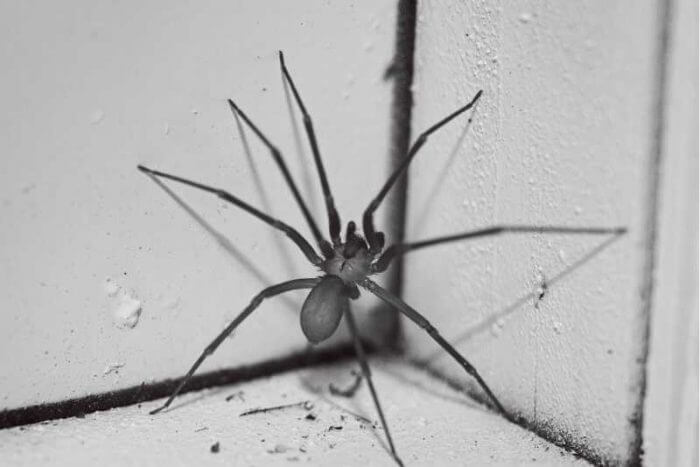
So, while brown recluse spiders are capable of making small leaps or jumps when threatened or disturbed, these movements are not comparable to the remarkable jumping abilities exhibited by jumping spiders.
Instead of actively pursuing or ambushing prey using jumps, they build irregular, loosely-constructed webs in hidden or secluded areas.
They can be found all over the world, from places like central Texas to western Georgia and north to Kentucky and even southeastern Nebraska, southern Iowa, Illinois, and Indiana to southwestern Ohio.
They typically build webs in dry undisturbed buildings, shelters, woodpiles, garages, and even closets, which are all perfect nesting grounds for these spiders.
Characteristics
- Range in color from medium brown to dark brown or blackish gray
- 6 eyes are arranged in pairs, one median pair and two lateral pairs
- Violin marking from the neck pointing to its rear
Size
- Adult females grow slightly larger compared to the males of 9 mm
- The size of an adult male is around 8 mm
4. Cellar Spiders
Cellar Spiders (Pholcidae family) are a group of spiders known for their long, slender legs and preference for dark, damp environments like cellars, basements, and caves. While these spiders do rely on web building to catch their prey there are some that do occasionally jump from time to time.
However, this only happens when they are disturbed or threatened, and when they do jump they are not as powerful or precise as those exhibited by jumping spiders.
Instead, they rely more on their long legs and ability to move quickly across their webs and surrounding surfaces to navigate their environment and escape potential threats.
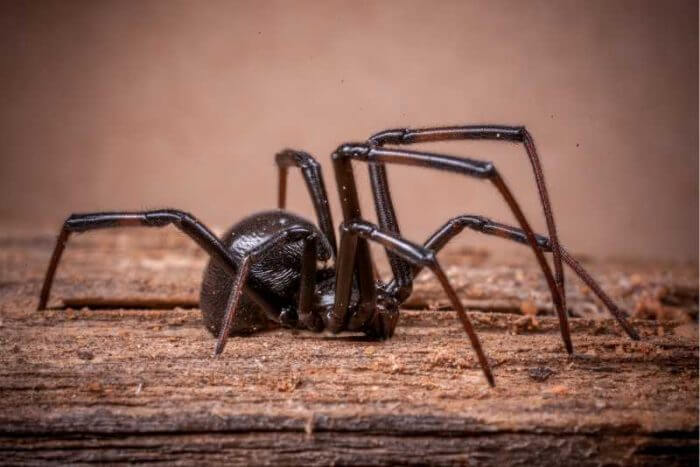
These spiders can be found constructing loose, irregular webs in corners and crevices near the ceiling or other high locations within their chosen environment. Once an insect becomes entangled in the web, “well” you do the rest!
Characteristics
- Cylindrical abdomens
- The body resembles the shape of a peanut
- Eyes are arranged in two groups of three
- Brown or dark grey, almost black in color
Size
- The body is around 2 to 10 mm in length
- Legs can be 4 times the size of their body up to 50 mm (1.97 inches)
5. Wolf Spiders
Wolf Spiders (Lycosidae) are a diverse group of spiders known for their robust build, excellent eyesight, and hunting prowess. While they are not primarily classified as jumping spiders, they do possess some jumping abilities that play a role in their hunting strategies and navigation.
Once the wolf spider is within striking distance, it uses its jumping ability to pounce on its prey. These jumps are typically short but quick, allowing the spider to seize its target before it has a chance to escape.
In addition to using jumps for capturing prey, wolf spiders may also use their jumping capabilities to evade predators or escape from dangerous situations.
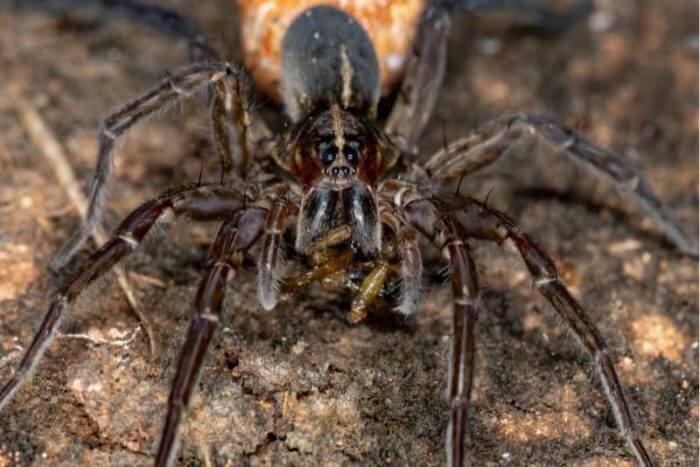
For example, if a larger predator approaches, the wolf spider can make a sudden jump to quickly move out of harm’s way, taking advantage of its agility and speed to find a safe hiding spot.
They may also use jumping as a warning or defensive mechanism to deter potential threats. When they feel threatened, these spiders may perform sudden jumps or display erratic movements to startle the approaching predator and signal that they are not an easy target.
Characteristics
- Eight eyes arranged in three rows
- The bottom row consists of four small eyes,
- The middle row has two large eyes, the top row has two medium eyes
Size
- Body size can be 10 to 35 mm (0.4 to 1.38 in), legs not included
Why Do Spiders Jump?
Spiders jump for various reasons, including hunting, defense, and navigation. Jumping is an effective strategy that helps spiders adapt to different situations and environments, increasing their chances of survival. Here are the main reasons why spiders jump:
- Hunting and capturing prey: Some spiders, like jumping spiders, use their jumping abilities to actively hunt and capture prey. They have powerful leg muscles and excellent vision, enabling them to calculate distances accurately and leap onto their target with precision. This hunting strategy allows them to catch fast-moving insects or surprise unsuspecting prey.
- Defense and evasion: Spiders may use jumping as a defensive tactic to escape potential threats or deter predators. When confronted by a predator, a spider can perform sudden jumps or display erratic movements to startle the attacker or create confusion, increasing the chance of a successful escape.
- Navigation and exploration: Jumping can help spiders move more efficiently within their environment, especially when crossing gaps or navigating complex terrain. For instance, jumping spiders use a combination of walking and jumping to explore their surroundings and find suitable locations for building nests or hunting for prey.
- Mate attraction and courtship: In some spider species, males perform elaborate jumping displays during courtship to attract females. These displays showcase the male’s agility, strength, and coordination, which are essential qualities for successful mating and reproduction.
Why Can’t All Black Spiders Jump?
While many spider species are known for their impressive jumping abilities, there are some black spiders seem to lack this skill. So why can’t all black spiders jump? Well, the answer lies in their anatomy.
Unlike jumping spiders, which have an enlarged abdomen and powerful muscles that allow them to spring forward, many black spider species have a more compact body type that isn’t conducive to jumping.
Additionally, some black spiders may rely more heavily on other hunting techniques, such as web building, or they may simply not encounter situations where jumping would be beneficial.
While it may be disappointing to not see a black spider jump, there’s still plenty to appreciate about these fascinating creatures and the unique adaptations they’ve developed to survive in their environments.
Are Black Spiders That Can Jump Dangerous?
It’s important to note that not all black jumping spiders are dangerous, and their potential threat really depends on the species. Accurate identification is crucial in determining the level of danger associated with a spider.
Just remember to exercise caution when dealing with unfamiliar spiders, and if bitten by a spider, monitor the symptoms and seek medical attention if necessary.
Some spiders including jumping spiders do have venom in their bite that they use to subdue their prey, but their venom is not harmful to humans.
In fact, jumping spiders are usually quite friendly towards humans, and will only bite as a last resort when they feel threatened or cornered.
How To Handle One Of These Black Spiders?
Handling a black jumping spider, or any spider for that matter, should be done with caution and care. So to help you with this here are some steps to safely handle a black jumping spider:
Wear protective gloves:
To protect yourself from potential bites, wear a pair of gloves made from a thick material like leather or gardening gloves.
Use a container:
Find a small container with a lid, such as a plastic cup or a glass jar. Gently place the container over the spider, trapping it inside. Be careful not to crush the spider while doing this.
Slide a thin, sturdy object underneath:
Once the spider is trapped in the container, carefully slide a thin, sturdy object, like a piece of cardstock or a plastic lid, underneath the container. This will create a barrier between the spider and the surface it’s on, allowing you to lift the container with the spider inside.
Secure the container:
While holding the thin object under the container, gently lift both the container and the thin object together, making sure the spider remains inside. Place the lid on the container to secure the spider safely.
Move the spider:
If you need to move the spider to another location, you can now safely transport it in the closed container. When releasing the spider, gently remove the lid and use the thin object to create an exit for the spider to crawl out onto a suitable surface.
Avoid direct handling:
It’s generally best to avoid directly handling a jumping spider with your hands, as they are fast and unpredictable, which could lead to accidental injury to the spider or a bite to you.
Remember, always exercise caution when handling spiders, and if you’re unsure about the species or its potential danger, it’s best to avoid handling it altogether and seek assistance from a professional.
Conclusion
So there you have it, not only do you know what types of black spiders can jump but you also know the reasons why they jump and how to safely remove one if needed.
If you want to learn more about spiders don’t forget we have plenty more articles like this one that you should find interesting. Visit our home page to learn more!



